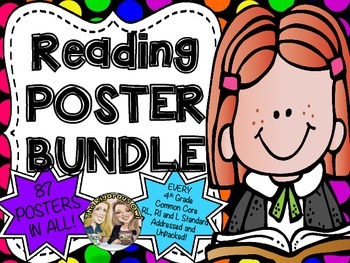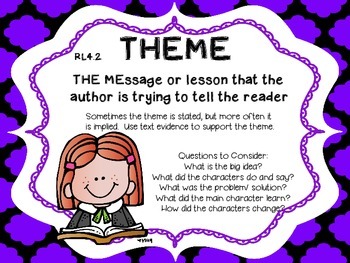4th Grade Reading Anchor Charts
The Rigorous Owl
14.4k Followers
Grade Levels
4th
Subjects
Resource Type
Standards
CCSSRL.4.2
CCSSRL.4.3
CCSSRL.4.4
CCSSRL.4.5
CCSSRL.4.6
Formats Included
- PDF
Pages
89 pages
The Rigorous Owl
14.4k Followers
What educators are saying
It took me a long time to decide on which anchor charts to buy for reading. I made the right choice buying these. Thank you for the awesome anchor charts!
Description
WOW! THIS BUNDLE HAS IT ALL!
This MEGA POSTER BUNDLE OF 87 POSTERS has every RL, RI and L 4th Grade Common Core Standard addressed and unpacked to the fullest. This is an amazing resource and teaching tool!
Posters address Key Ideas and Details, Craft and Structure, Vocabulary and Language Acquisition, Language and Informational Text Standards!
Posters have each topic explained in detail in Kid Friendly terminology.
Posters have definitions, charts, lists, questions to consider, and cute graphics to go along with each one. Each domain is color coded differently. These will look great on your wall and you'll wonder how you ever taught without them!
Posters included:
Making Inferences
Textual Evidence Sentence Starters
Theme
Common Themes in Literature
Mood
Tone
Common Moods and Tones in Literature
Character Traits
List of Character Traits (over 150)
Character Change
Character Analysis
Protagonist/ Antagonist
Types of Characters (Major/Minor/Static/Dynamic)
Plot
Setting
Character Motivation
Common Character Motivations List
Allusions
Poetry
Prose
Drama
Author's Purpose
Point of View
Perspective
Text v. Visual or Oral Presentation
Comparing Themes across Cultures
Common Themes across Cultures
Context Clues
Examples of Context Clues
Prefixes
Top 20 Prefixes for 4th graders
Roots
Top 20 Roots for 4th Graders
Suffixes
Top 20 Suffixes for 4th Graders
Types of Reference Materials
Parts of a Book
Similes
List of Common Similes
Metaphors
List of Common Metaphors
Proverbs and Adages
List of Common Proverbs and Adages
Idioms
Common List of Idioms
Academic Vocabulary
Relative Adverbs
Relative Pronouns
Progressive Tense Verbs
Modal Auxiliaries
Ordering Adjectives
Prepositions with List
Complete Sentences
Fragments
Run-ons
Top 20 Commonly Confused Words
Top 10 Capitalization Rules
Punctuating Dialogue
Coordinating Conjunctions
Top 5 Spelling Rules
Precise Nouns and Vivid Verbs
Punctuating for Effect
Formal and Informal Language
Informational Text Posters
Making Inferences
Main Idea and Supporting Details
Writing a Summary
Reading Technical, Scientific and Historical Text
Academic Vocabulary
Text Structure (a poster for each):
Descriptive, Problem Solution, Cause and Effect, Compare and Contrast, Proposition and Support, and Sequential/ Chronological
Firsthand Account
Secondhand Account
Nonfiction Text Features:
Titles, Headings, Subheadings, Sidebars, Bold/ Key Words, Timelines, Maps, Tables, Graphs, Diagrams, Labels, and Bullets
Photographs v. Illustrations
Author's Reasons and Evidence
Using Multiple Sources
Like what you see? Check out our store
https://www.teacherspayteachers.com/Store/The-Rigorous-Owl
This MEGA POSTER BUNDLE OF 87 POSTERS has every RL, RI and L 4th Grade Common Core Standard addressed and unpacked to the fullest. This is an amazing resource and teaching tool!
Posters address Key Ideas and Details, Craft and Structure, Vocabulary and Language Acquisition, Language and Informational Text Standards!
Posters have each topic explained in detail in Kid Friendly terminology.
Posters have definitions, charts, lists, questions to consider, and cute graphics to go along with each one. Each domain is color coded differently. These will look great on your wall and you'll wonder how you ever taught without them!
Posters included:
Making Inferences
Textual Evidence Sentence Starters
Theme
Common Themes in Literature
Mood
Tone
Common Moods and Tones in Literature
Character Traits
List of Character Traits (over 150)
Character Change
Character Analysis
Protagonist/ Antagonist
Types of Characters (Major/Minor/Static/Dynamic)
Plot
Setting
Character Motivation
Common Character Motivations List
Allusions
Poetry
Prose
Drama
Author's Purpose
Point of View
Perspective
Text v. Visual or Oral Presentation
Comparing Themes across Cultures
Common Themes across Cultures
Context Clues
Examples of Context Clues
Prefixes
Top 20 Prefixes for 4th graders
Roots
Top 20 Roots for 4th Graders
Suffixes
Top 20 Suffixes for 4th Graders
Types of Reference Materials
Parts of a Book
Similes
List of Common Similes
Metaphors
List of Common Metaphors
Proverbs and Adages
List of Common Proverbs and Adages
Idioms
Common List of Idioms
Academic Vocabulary
Relative Adverbs
Relative Pronouns
Progressive Tense Verbs
Modal Auxiliaries
Ordering Adjectives
Prepositions with List
Complete Sentences
Fragments
Run-ons
Top 20 Commonly Confused Words
Top 10 Capitalization Rules
Punctuating Dialogue
Coordinating Conjunctions
Top 5 Spelling Rules
Precise Nouns and Vivid Verbs
Punctuating for Effect
Formal and Informal Language
Informational Text Posters
Making Inferences
Main Idea and Supporting Details
Writing a Summary
Reading Technical, Scientific and Historical Text
Academic Vocabulary
Text Structure (a poster for each):
Descriptive, Problem Solution, Cause and Effect, Compare and Contrast, Proposition and Support, and Sequential/ Chronological
Firsthand Account
Secondhand Account
Nonfiction Text Features:
Titles, Headings, Subheadings, Sidebars, Bold/ Key Words, Timelines, Maps, Tables, Graphs, Diagrams, Labels, and Bullets
Photographs v. Illustrations
Author's Reasons and Evidence
Using Multiple Sources
Like what you see? Check out our store
https://www.teacherspayteachers.com/Store/The-Rigorous-Owl
Total Pages
89 pages
Answer Key
Does not apply
Teaching Duration
Lifelong tool
Report this resource to TPT
Reported resources will be reviewed by our team. Report this resource to let us know if this resource violates TPT’s content guidelines.
Standards
to see state-specific standards (only available in the US).
CCSSRL.4.2
Determine a theme of a story, drama, or poem from details in the text; summarize the text.
CCSSRL.4.3
Describe in depth a character, setting, or event in a story or drama, drawing on specific details in the text (e.g., a character’s thoughts, words, or actions).
CCSSRL.4.4
Determine the meaning of words and phrases as they are used in a text, including those that allude to significant characters found in mythology (e.g., Herculean).
CCSSRL.4.5
Explain major differences between poems, drama, and prose, and refer to the structural elements of poems (e.g., verse, rhythm, meter) and drama (e.g., casts of characters, settings, descriptions, dialogue, stage directions) when writing or speaking about a text.
CCSSRL.4.6
Compare and contrast the point of view from which different stories are narrated, including the difference between first- and third-person narrations.





